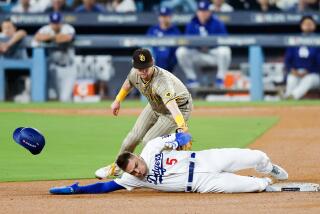The art of the steal: Is it becoming lost in baseball?
Thirty years ago, Rickey Henderson stole 130 bases in a baseball season. The following year, he racked up 108.
And he wasn’t in a league of his own. The 100-stolen-base barrier has been cracked 21 times. Ninety bases? Thirty-five times.
Yet none in the last 25 years.
The highest number of stolen bases in the major leagues in the last decade was 78 by Jose Reyes in 2007, followed by Jacoby Ellsbury, who stole 70 in 2009.
So when a minor league player named Billy Hamilton stole his 100th base of the season last week, his feat quickly began making the rounds in major league clubhouses. After all, what he’s doing hasn’t been done on any level of baseball for two decades.
Hamilton has more than tripled this season’s major league leader — Dodgers shortstop Dee Gordon, who collected his 30th stolen base before suffering a dislocated thumb on July 4.
Gordon was on pace to steal about 57 bases — normal for the high mark in a season these days.
“Certainly there’s been a lot more emphasis in the last generation in controlling the running game than there was before,” said Angels Manager Mike Scioscia, whose leadoff hitter, Mike Trout, leads the American League with 26 steals before Friday. “Now it’s more difficult to steal a lot of bases.”
Pitchers have eliminated the high leg kick when working out of a stretch, replacing it with a slide step that speeds up the time in which they release the ball. Also, more emphasis is placed on how quickly a catcher releases a throw and the strength of his arm.
Even scouting reports have changed. In addition to profiling pitchers and hitters, reports provide in-depth details about an opposing team’s baserunning capabilities, creating a third tier of analysis.
Dodgers outfielderTony Gwynn Jr.believes the game’s “steroid era” also played a role. After all, he said, why would a team risk trying to steal a base when there was a good chance the batter would knock one out of the park?
Another factor is the modern school of statistical analysis known as sabermetrics, one tenet of which holds that the risk of incurring an out on the basepaths outweighs the potential benefit of stealing a base.
Maury Wills and Dave Lopes, who combined for 1,143 stolen bases in their big league careers, say there are simply fewer players who dedicate themselves to the art of the steal.
Lopes, the Dodgers’ first base coach, said a base stealer must have both the desire to run and instincts to know when to strike. He said it’s rare to find players today who have that combination, and then act on it.
“Guys don’t push themselves anymore,” Lopes said.
Wills, a Dodgers instructor, said today’s players are meticulously taught how to hit but not how to steal.
Additionally, there’s often a price for stealing bases, and Wills and Lopes said some teams would prefer their players not pay it. The toll on a player’s body can be severe. Wills used to sit in an ice bath long after his teammates had left the clubhouse following a game.
Dodgers shortstop Gordon sustained his injury on a head-first slide, when his thumb was caught underneath the bag. He’s expected to miss six weeks.
“A lot of players don’t want to go through all that,” Wills said. “It’s so much easier to go up there and hit the single and go to first base and wait for somebody to hit one in the gap.”
Lopes says it will take someone with a lot of speed, arrogance and gumption to again reach triple digits in steals at the major league level.
The type of player the game hasn’t seen since Henderson.
Maybe Trout, whose 26 steals in 64 games from his late-April call-up from triple A until the All-Star break projected to more than 70 over a full 162-game season.
Or maybe Billy Hamilton.
“If a kid can steal more than 100 bases in the minors, and he can get on base,” Lopes said, “I wouldn’t bet against him.”
More to Read
Go beyond the scoreboard
Get the latest on L.A.'s teams in the daily Sports Report newsletter.
You may occasionally receive promotional content from the Los Angeles Times.










